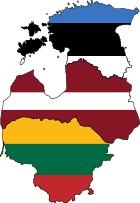Guerrilla war in the Baltic states
| Guerilla war in the Baltic states | |||||||
|---|---|---|---|---|---|---|---|
| Part of Occupation of the Baltic states | |||||||
| |||||||
| Belligerents | |||||||
|
Supported by |
| ||||||
| Strength | |||||||
| ~50,000 partisans | ? | ||||||
| Casualties and losses | |||||||
|
|
| ||||||
The Guerrilla war in the Baltic states was the armed struggle against Soviet rule that spanned from 1944 to the mid-1950s.[1] After the conquest of the Baltic territories by the Soviets in 1944, an insurgency involving nationalist partisans started. According to some estimates, 10,000 partisans in Estonia, 10,000 partisans in Latvia and 30,000 partisans in Lithuania and many more supporters were involved. This war continued as an organised struggle until 1956 when the superiority of the Soviet military caused the native population to adopt other forms of resistance. While estimates related to the extent of partisan movement vary, but there seems to be a consensus among researchers that by international standards, the Baltic guerrilla movements were extensive. Proportionally, the partisan movement in the post-war Baltic states was of a similar size as the Viet Cong movement in South Vietnam.[2]
See also
References
- ↑ Statiev, Alexander (2010). The Soviet Counterinsurgency in the Western Borderlands. Cambridge University Press.
- ↑ Ziemele, Ineta (2005). State Continuity and Nationality: The Baltic States and Russia. Martinus Nijhoff Publishers. p. 25. ISBN 90-04-14295-9.
- Tauras, KV (1962). Guerrilla Warfare on the Amber Coast. New York: Voyages Press.

